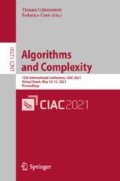Abstract
In this paper we consider the multi-budget maximum weighted coverage problem, a generalization of the classical maximum coverage problem, where we are given k budgets, a set X of elements, and a set \(\mathcal {S}\) of bins where any \(S \in \mathcal {S}\) is a subset of elements of X. Each bin S has its own cost, and each element its own weight. An outcome is a vector \(O=(O_1, \dots , O_k)\) where each budget \(b_i\), for \(i=1,\dots , k\), can be used to buy a subset of bins \(O_i \subseteq \mathcal {S}\) of overall cost at most \(b_i\). The objective is to maximize the total weight which is defined as the sum of the weights of the elements bought with the budgets.
We consider the classical combinatorial optimization problem of computing an outcome which maximizes the total weight and provide a \(\left( 1-\frac{1}{\sqrt{e}}\right) \)-approximation algorithm for the case when the maximum cost of a bin is upper-bounded by the minimum budget, i.e. the case in which each budget can be used to buy any bin. Moreover, we give a randomized Monte-Carlo algorithm for the general case that runs in polynomial time, satisfies the budget constraints in expectation, and guarantees an expected \(1-\frac{1}{e}\) approximation factor.
Access this chapter
Tax calculation will be finalised at checkout
Purchases are for personal use only
Notes
- 1.
To see this, observe that function \(1- e^{-p }\) is concave for \(p>0\) and it is equal to 0 when \(p=0\) and to \(1- e^{-1}\) when \(p=1\).
References
Buchbinder, N., Feldman, M., Naor, J., Schwartz, R.: A tight linear time (1/2)-approximation for unconstrained submodular maximization. In: Proceedings of FOCS, pp. 649–658 (2012). https://doi.org/10.1109/FOCS.2012.73
Călinescu, G., Chekuri, C., Pál, M., Vondrák, J.: Maximizing a monotone submodular function subject to a matroid constraint. SIAM J. Comput. 40(6), 1740–1766 (2011). https://doi.org/10.1137/080733991
Caragiannis, I., Monaco, G.: A 6/5-approximation algorithm for the maximum 3-cover problem. J. Comb. Optim. 25(1), 60–77 (2013). https://doi.org/10.1007/s10878-011-9417-z
Cellinese, F., D’Angelo, G., Monaco, G., Velaj, Y.: Generalized budgeted submodular set function maximization. In: Proceedings of MFCS. LIPIcs, vol. 117, pp. 31:1–31:14 (2018). https://doi.org/10.4230/LIPIcs.MFCS.2018.31
Chakrabarty, D., Goel, G.: On the approximability of budgeted allocations and improved lower bounds for submodular welfare maximization and gap. In: Proceedings of FOCS, pp. 687–696 (2008). https://doi.org/10.1137/080735503
Chekuri, C., Kumar, A.: Maximum coverage problem with group budget constraints and applications. In: Jansen, K., Khanna, S., Rolim, J.D.P., Ron, D. (eds.) APPROX/RANDOM-2004. LNCS, vol. 3122, pp. 72–83. Springer, Heidelberg (2004). https://doi.org/10.1007/978-3-540-27821-4_7
Chekuri, C., Vondrák, J., Zenklusen, R.: Submodular function maximization via the multilinear relaxation and contention resolution schemes. SIAM J. Comput. 43(6), 1831–1879 (2014)
Cohen, R., Katzir, L.: The generalized maximum coverage problem. Inf. Process. Lett. 108(1), 15–22 (2008). https://doi.org/10.1016/j.ipl.2008.03.017
Farbstein, B., Levin, A.: Maximum coverage problem with group budget constraints. J. Comb. Optim. 34(3), 725–735 (2017). https://doi.org/10.1007/s10878-016-0102-0
Feige, U.: A threshold of ln n for approximating set cover. J. ACM 45(4), 634–652 (1998). https://doi.org/10.1145/237814.237977
Feige, U., Mirrokni, V.S., Vondrák, J.: Maximizing non-monotone submodular functions. In: Proceedings of FOCS, pp. 461–471 (2007). https://doi.org/10.1137/090779346
Filmus, Y., Ward, J.: Monotone submodular maximization over a matroid via non-oblivious local search. SIAM J. Comput. 43(2), 514–542 (2014). https://doi.org/10.1137/130920277
Gairing, M.: Covering games: approximation through non-cooperation. In: Proceedings of WINE, pp. 184–195 (2009). https://doi.org/10.1007/978-3-642-10841-9_18
Goel, G., Karande, C., Tripathi, P., Wang, L.: Approximability of combinatorial problems with multi-agent submodular cost functions. In: Proceedings of FOCS, pp. 755–764 (2009). https://doi.org/10.1109/FOCS.2009.81
Goel, G., Tripathi, P., Wang, L.: Combinatorial problems with discounted price functions in multi-agent systems. In: Proceedings of the FSTTCS, pp. 436–446 (2010). https://doi.org/10.4230/LIPIcs.FSTTCS.2010.436
Hochbaum, D.: Approximation Algorithms for NP-Hard Problems. PWS Publishing Company, Boston (1997). https://doi.org/10.1145/261342.571216
Iwata, S., Nagano, K.: Submodular function minimization under covering constraints. In: Proceedings of FOCS, pp. 671–680 (2009). https://doi.org/10.1109/FOCS.2009.31
Iyer, R.K., Bilmes, J.A.: Submodular optimization with submodular cover and submodular knapsack constraints. In: Proceedings of NIPS, pp. 2436–2444 (2013). https://doi.org/10.1145/1374376.1374389
Khuller, S., Moss, A., Naor, J.S.: The budgeted maximum coverage problem. Inf. Process. Lett. 70(1), 39–45 (1999). https://doi.org/10.1016/S0020-0190(99)00031-9
Kulik, A., Shachnai, H., Tamir, T.: Approximations for monotone and nonmonotone submodular maximization with knapsack constraints. Math. Oper. Res. 38(4), 729–739 (2013)
Lee, J., Sviridenko, M., Vondrák, J.: Submodular maximization over multiple matroids via generalized exchange properties. Math. Oper. Res. 35(4), 795–806 (2010). https://doi.org/10.1007/978-3-642-03685-9_19
Marden, J.R., Wierman, A.: Distributed welfare games. Oper. Res. 61(1), 155–168 (2013). https://doi.org/10.1287/opre.1120.1137
Nemhauser, G.L., Wolsey, L.A., Fisher, M.L.: An analysis of approximations for maximizing submodular set functions-I. Math. Program. 14(1), 265–294 (1978). https://doi.org/10.1007/BF01588971
Santiago, R., Shepherd, F.B.: Multi-agent submodular optimization. In: Proceedings of APPROX/RANDOM. LIPIcs, vol. 116, pp. 23:1–23:20 (2018). https://doi.org/10.4230/LIPIcs.APPROX-RANDOM.2018.23
Santiago, R., Shepherd, F.B.: Multivariate submodular optimization. In: Proceedings of ICML, vol. 97, pp. 5599–5609. PMLR (2019)
Sviridenko, M.: A note on maximizing a submodular set function subject to a knapsack constraint. Oper. Res. Lett. 32(1), 41–43 (2004). https://doi.org/10.1016/S0167-6377(03)00062-2
Vondrak, J.: Optimal approximation for the submodular welfare problem in the value oracle model. In: Proceedings of STOC, pp. 67–74. ACM (2008). https://doi.org/10.1145/1374376.1374389
Ward, J.: A (k+3)/2-approximation algorithm for monotone submodular k-set packing and general k-exchange systems. In: Proceedings of STACS, pp. 42–53 (2012). https://doi.org/10.4230/LIPIcs.STACS.2012.42
Author information
Authors and Affiliations
Corresponding author
Editor information
Editors and Affiliations
Rights and permissions
Copyright information
© 2021 Springer Nature Switzerland AG
About this paper
Cite this paper
Cellinese, F., D’Angelo, G., Monaco, G., Velaj, Y. (2021). The Multi-budget Maximum Weighted Coverage Problem. In: Calamoneri, T., Corò, F. (eds) Algorithms and Complexity. CIAC 2021. Lecture Notes in Computer Science(), vol 12701. Springer, Cham. https://doi.org/10.1007/978-3-030-75242-2_12
Download citation
DOI: https://doi.org/10.1007/978-3-030-75242-2_12
Published:
Publisher Name: Springer, Cham
Print ISBN: 978-3-030-75241-5
Online ISBN: 978-3-030-75242-2
eBook Packages: Computer ScienceComputer Science (R0)

